Loch flies
{{start}}
Loch Style fly-fishing involves fly-fishing from a boat, side onto the wind, using a system incorporating one or a number of flies. There are both wet and dry lock style fishing techniques. There are four distinct sub sections of loch flies: wake or bob flies, dropper flies that can be placed in various position s in a team of flies for different effects, attractor flies which are generally fished on a middle dropper and point flies.
The dry fly technique involves casting out in the direction of the drift, stopping the cast above the water so as to let the team of flies settle, waiting the desired time (often only 5 to 10 seconds) and then repeating the process in a slightly different position. Dry fly Loch style fly fishing covers a lot of water in a short time. The flies used are ordinary dry flies such as those shown in the dry fly page of this website. When selecting a team of flies try to balance the selection so that the most aerodynamic fly is on the point and the least aerodynamic fly is on the top dropper.
The wet technique involves casting out in the direction of the drift, fishing the flies using a range of techniques. Wet fly loch fly fishing, as well as incorporating a range of different retrieves and fly lines ranging from floating right through to very fast sinking lines can also involve fishing: the drop, the retrieve, the stop, the lift, the hang and the dibble and the dapple.
{{end}}

{{+1}}Squirmy caddis{{-1}}
{{start}}
Somewhat of a fusion of a traditional caddis pupa emerger and a squirmy wormy this fly has earned a place in my fly box as a great middle or top dropper fly for both a loch style team and a river team.{{end}}
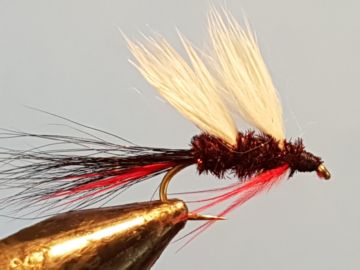
{{+1}}Claret caddis{{-1}}
{{start}}
Any time there are caddis on the wing this fly is worth a swim in the middle position of a team of three loch flies. One of the most important things to remember when tying this fly is not to overdress it ... make sure you can see a gap between the two wings even when the rabbit fur is dry and fluffed out.{{end}}

{{+1}}Epoxy midge – black with hot butt & UV cheeks{{-1}}
{{start}}
When Chironomids are around they tend to be around in large numbers and trout become quickly switched on and gorge on them. There are number of techniques to target chironomid feeders and one of my favourite is to fish three chironomid imitations with the heaviest on the point with a long leader on a floating line and fish relatively static. You will be surprised how many fish find your flies.{{end}}
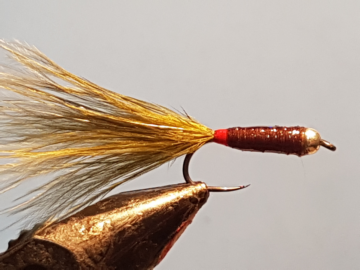
{{+1}}Olive epoxy bugger -silver TBH, UV spine & orange butt{{-1}}
{{start}}
Because of the lack of body dressing and the epoxy body this fly sinks quickly and the mirage tinsel spine that I have added flashes, in a way I am confident will be enticing, to stocked rainbows in particular, as the fly is being worked back to the boat or shore are very enticing.{{end}}
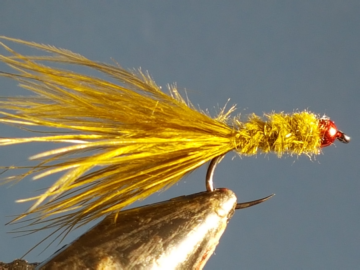
{{+1}}Red TBH damsel{{-1}}
{{start}}
I first used this fly in Canada in 2016 at the Commonwealth Fly Fishing Championships. Tied by Josh Flowers from Tasmania I doubt that a session on the lakes passed without every team member tying this fly on for at lease some of the time. I have since learned that it’s a very successful fly in Central Tasmania at any time when damsels are around.{{end}}
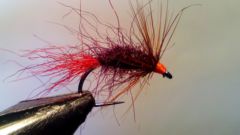
{{+1}}Claret carrot{{-1}}
{{start}}
Based on the design of the carrot fly this version is particularly appealing to fish feeding on emerging Mayfly in Tasmania's central and western lake.{{end}}
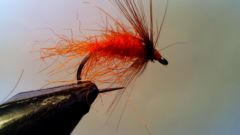
{{+1}}Carrot dry fly{{-1}}
{{start}}
Tied with natural seals fur it is a fly that sits well on the water and easily sheds water with a snappy false cast.{{end}}

{{+1}}Cormorant{{-1}}
{{start}}
Cormorant flies have plenty of movement generated through the wispy marabou wing that extends the full length of the fly and has, as a hot spot, a very visible chartreuse tag.{{end}}

{{+1}}Sparkler{{-1}}
{{start}}
When a seriously flashy fly is needed because of visibility or you just need a fly to excite fish this fly may save the day.{{end}}
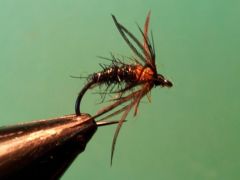
{{+1}}Tiger bibio{{-1}}
{{start}}
This combination of my Bibio variant and Peter Walsh's tiger midge. Fish it in the same way as you would fish a bibio ... often it will come up trumps.{{end}}













